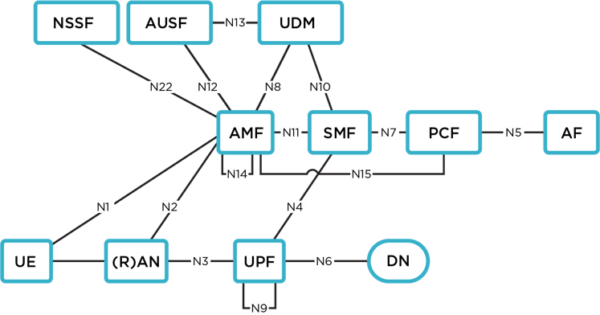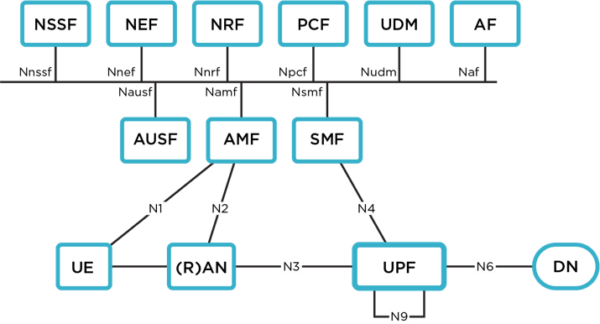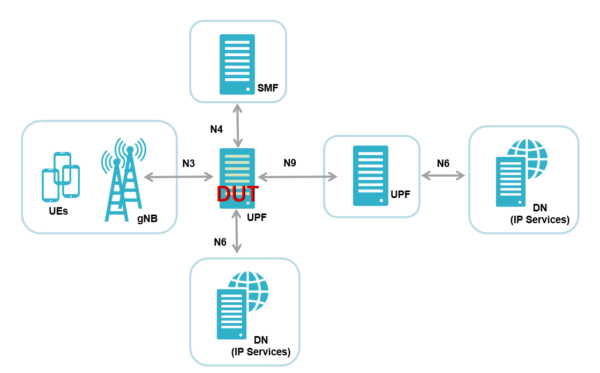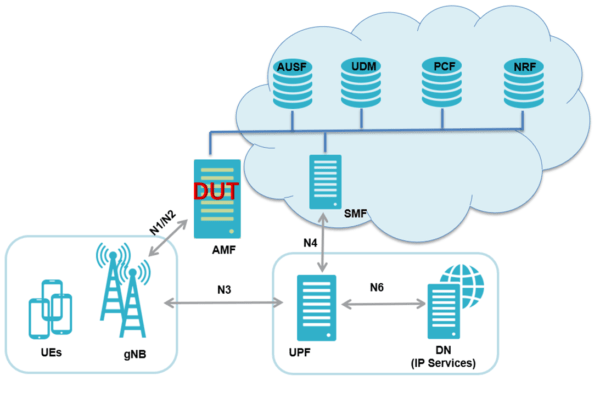5G is revolutionizing the core network with new concepts such as network slicing and multi-access edge computing (MEC). Although not a new concept in 5G, MEC is one of the key drivers for 5G adoption. It enables offloading traffic at the edge, which is key to achieve the economics of 5G for service delivery. MEC also helps save network bandwidth and makes achieving low-latency requirements possible, among other benefits. In addition to MEC, the 5G core (5GC) network is moving to a service-based architecture (SBA) and control user plane separation (CUPS) to increase deployment flexibility. These shifts translate into significant challenges for engineers. Mobile network operators (MNOs) need a new test approach to validate the 5GC network.
Overview of 3GPP Mechanisms for MEC
In the past, MNOs and network equipment manufacturers (NEMs) used dedicated boxes, hosts, and orchestrators that resided outside the third generation partnership project (3GPP) specification to implement MEC. Today, the 3GPP provides multiple mechanisms to implement MEC. They include user plane function (UPF) local routing and steering, MEC as an application function (AF), session service continuity (SSC), and local area data network (LADN).
- The UPF can play a critical role in local routing and traffic steering. One protocol data unit (PDU) session can have multiple N6 interfaces towards different data networks. Uplink classifiers (UL CLs) perform the traffic steering by operating a set of traffic filters that match the steered traffic.
- When MEC is implemented as an AF, it influences UPF (re)selection and traffic routing directly using the policy control function (PCF), or indirectly using the network exposure function (NEF). This implementation helps to monitor and optimize transmission latency and bandwidth consumption for location-based services and capabilities.
- User context transfer can be an issue when services are activated based on location. SSC addresses this need by enabling the application instance that is serving a user to change to a new location. 3GPP’s SSC mechanism is particularly important for stateful applications that require the transfer of the user context.
- 3GPP’s LADN mechanism for MEC implementation in 5G allows MNOs to limit the availability of an application to a certain geographic area. This capability is needed for gaming applications or geo-location services. This can also be helpful to limit certain applications to locations where their requirements can be met. Augmented reality (AR) and virtual reality (VR) applications, for example, have stringent latency requirements.
Move to SBA and CUPS
SBA is one of the revolutionary aspects of the 5GC network. There are 2 representations of SBA – reference point and service-based. The reference point representation describes point-to-point interaction between any two network functions (NFs). In the service-based representation, NFs within the control plane enable each other to interact and access their services.


The 5GC network also uses the CUPS concept introduced in 4G. CUPS allows the industry to achieve the goal of scaling the user and control plane separately. Multiple user plane entities can be deployed, independently from the control plane. The user plane components are closer to the edge of the network and to the user. This will help meet the stringent latency requirements from 3GPP and IMT-2020 targets. CUPS also allows for different configurations in different network slices. It is a stepping stone for the 5GC network because the same reference point is being reused for the N4 interface between the session management function (SMF) and the UPF interface.
Validating the New Core Network: 3 Key Areas of Focus
MNOs are building the core network differently in the 5G era. It is no longer built in incremental steps, with months between adding nodes and interfaces. Since the 3GPP’s release 15 (rel-15) in December 2017, the industry must implement the entire core network at once. Validating the 5GC network requires a holistic approach.
By isolating nodes, engineers can test individual interfaces, nodes, or groups of nodes and entire functionalities across the 5GC network in an end-to-end approach. Simulating user equipment (UE) across multiple nodes is critical to validate functionalities and services. Key areas of focus include testing the UPF, access and mobility management function (AMF), and SBA nodes in different node-level scenarios and for performance.
When testing the UPF with a node isolation approach, the nodes run on both the control and user planes. The test tool simulates the 5G base station (gNB), the SMF, and the data network. Assessing UPF performance in a variety of scenarios is critical. Engineers need to validate key performance indicators (KPIs) per node and for multiple ones. Quality of service (QoS) validation is particularly important for the UPF.

For the AMF, the UEs send connection and session information over N1 and N2 interfaces. The AMF is responsible for handling connection and mobility management tasks. All messages related to session management are forwarded over the N11 reference interface through the SMF. When testing the AMF, the focus is on control plane functional and capacity testing. Testing the AMF in isolation requires testing coordination of the N1/N2 interfaces from the gNB and simulation of the SBA nodes. The AMF should be tested in different node-level scenarios and performance ones.

Similar to UPF and AMF testing, various node-level and performance test scenarios must be deployed for testing the SBA nodes. At the node level, it is important to test for registration to network repository function (NRF), node failover, and elastic scaling. From a performance perspective, it is important to validate the rate of various procedures for UE authentication and context management, as well as subscriber data management. SBA nodes have a dual role as producer and consumer. Validating both roles is essential for a holistic approach.

Overcoming 5GC Network Challenges
With the approval of the non-standalone (NSA) deployment options in December 2017, the 3GPP accelerated the implementation of 5G. However, these deployment options use the long term evolution (LTE) base station to connect to the Evolved Packet Core (EPC), increasing the burden on the existing 4G infrastructure.
There are multiple NSA deployment options to choose from. MNOs can also select the SA options directly and deploy 5G in parallel to 4G. While different options provide flexibility, they also translate into increased complexity. In addition, the 5GC network is expected to support the explosion in cellular Internet of Things (IoT) devices, massive growth in network traffic, and real-time applications. 5G represents an exponential increase in technical complexity.
Yet, 5G mobile network deployments are accelerating. In the race to 5G, MNOs need the capability to emulate real-world environments to test the 5GC network and discover defects early. They must enable continuous integration and development (CD/CI) via automation means. More importantly, the 5GC network now needs to be tested throughout the workflow. Testing must span design, building, deployment, and maintenance. This trend generates the need for test tools that cover the entire product lifecycle and produce traceable and repeatable results in each phase.
For more information on 5G test challenges and solutions for MNOs, click here.
- The 5GC Network Revolution: MEC and SBA Testing - November 5, 2019



